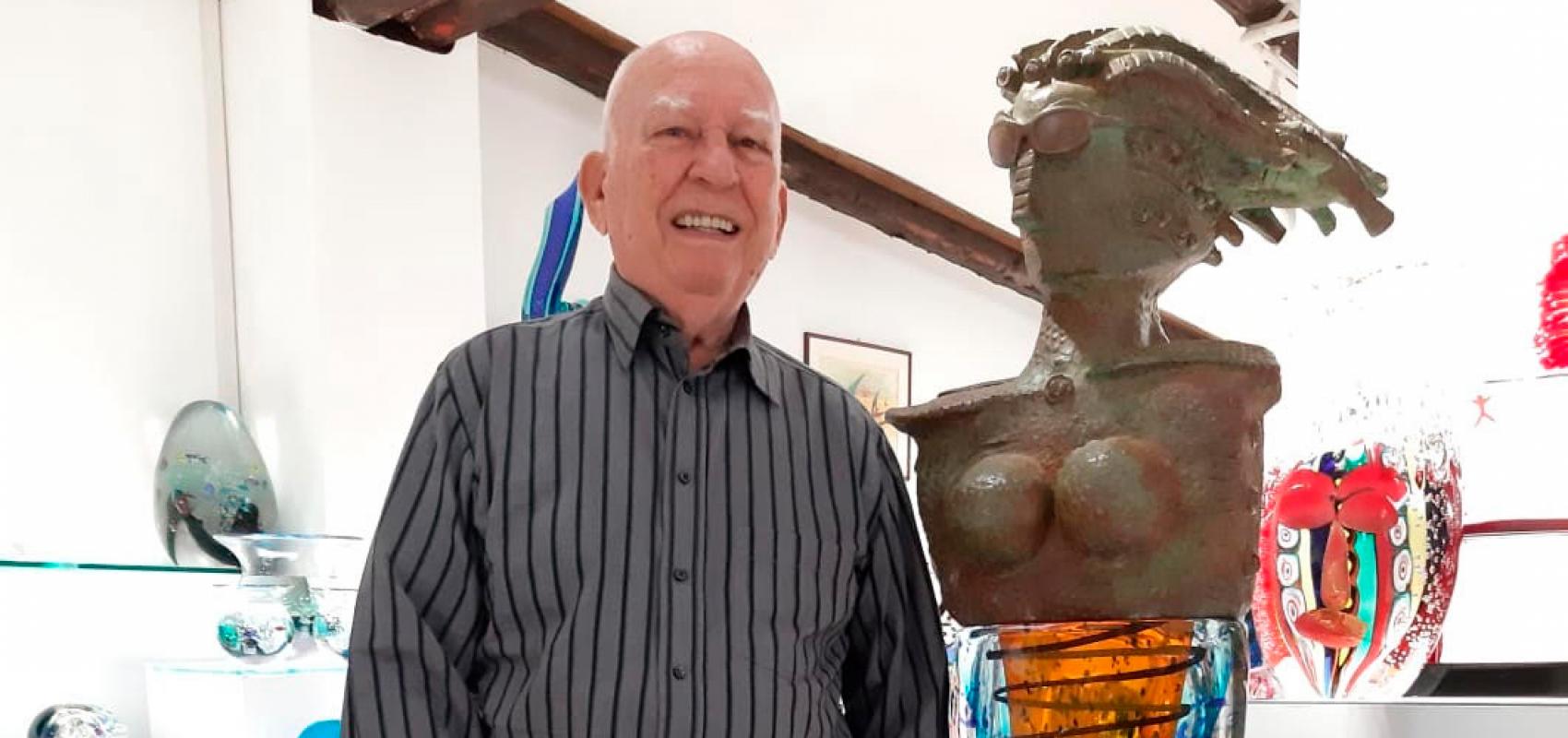By: Rufo Caballero
One could speak of coherence, but I would prefer to speak of consequence. Indeed, the portentous return of master Alfredo Sosabravo to the realm of painting (perhaps few remember that our first ceramist was a singular painter before) participates in an organic way in the predominance of the new pictorial sensibility that rules the plastic production of the nineties, and he does it adducing a similar aftertaste for the goodness of the form and the oasis of the craft that does not fail to subscribe to a certain ironic hedonism that restores the aesthetic paradigm in the plastic culture of these days.
However, unlike the tactical protagonism that such restitution takes on in not a few young artists devoted to a complicit skirmish with the demands of a market already exhausted of ephemeral art and ultra-avant-garde constructions, Sosabravo's neat and noble painting -certainly not exempt from a subtle irony in his case of white humor- responds to the inner and atavistic design of a poetics that has remained oblivious to fashions and ups and downs, although it has been enriched by every contemporary way of doing things that has contributed to its tessitura. That is why I prefer to speak of consequence.
Because even in the angriest moments of the crest of the avant-garde wave, when the group leaders strutted their deconstructive challenges, Alfredo Sosabravo, imperturbable, never hid his aestheticist condition. The years and the calm of the tide have then come to grant a definitive and transcendent letter of legitimacy to his creative calmness that had matured much earlier. While not a few of his colleagues and virtual disciples brandished spears in virtue of political clichés and vindications as just as circumstantial, the master was concentrating on the generic and universal scope of his work, which has always gravitated around two substantial thematic centers: nature and the preservation of its purity, and the human condition in its dissimilar contradictions and interstices. By wisely delving into both cosmoses, Sosabravo has been shifting those initial pretensions of remodeling Cuban-style "raw art" to the current colorful epiphanies of a painting whose first attribute is definitely nobility, as if its author had understood over the years and the backwater that there is nothing more important in this world than making people's lives happier, since reality has long, long ago taken care of the opposite.
It is not a complacent art; it is an edifying art with the authenticity of proclaiming to the four winds that in spite of everything, life is beautiful and good. Nobility of spirit that we needed, frankly. Among so much destructive hoisting, given the fury of the elements, Sosabravo has always been our balm of purity, relief and resurrection. Someone recently compared him to another immense painter of ours, calling him "the Portocarrero of the nineties", and it is obvious that the relationship transcends the baroque or the riot of color to focus on a more interior sense of the very nature of creation, where both masters gestated a repertoire of motifs that founded values, built paradigms, redeemed the being with the illusion of beauty and the promised land of the playful sublime. And of course the component of play is consubstantial to the not at all sacred will of Sosabravo who, in order to aestheticize reality, has not had to canonize too much the virtue of beauty.
There is a phrase of his that in my opinion summarizes all his work, the one that confesses that "my soul is still romantic", even with reminiscences of noveau, but it is a soul that would like to inhabit a psychedelic house, or at least "aerodynamic". This means that the ambition of neatness and formalization has never been at odds with the aesthetic risk, with the dynamics of continuous changes, with the subtle mutations that in his work swing from ceramics to painting, or from painting to graphics. His identity as an author is strengthened by a sufficiently organic internalization of the sources, behind which always emerges a set of signs that speak of the integrity of a poetics with the independence of times and supports; there are the cryptic arrows and broken lines, the immovable force of the black outline, the thoughtful randomness of color, or the arbitrary and dislocating rupture of the system that for the moment destabilizes - and enriches - a design from the tension that arises between the struggle of the volume that results from the undeniable ceramic experience and the secular planimetric surface with whose superimpositions of planes and various texts structuring the composition, the master has liked to pay heartfelt tributes to his other devotions: the aesthetics of comics and the fascination of cinema as a teller of exciting stories.
Some of Sosabravo's pieces are inspired by films and film characters: in the past, De repente en el verano or Dulce pájaro de la juventud were the motivations, today renewed by the contagious iconoclasm of Almodóvar or, already in its most retro spirit, Tarzan's monkey as the grand dame of cinema. This treatment halfway between parody and intimate homage reaches special prominence in the painting dedicated to the accursed manchego whose delirious comedies like Mujeres al borde de un ataque de nervios and Kika have stimulated the healthy and tasty humor of the master.
If at the moment of genesis we could pinpoint Sosabravo's empathy with works like those of Acosta Leon or Dubuffet, today it is not only improbable but ridiculous to try to label him in any way. He is already irreducible and irreplaceable like all great artists and his world of references begins to be his own cosmos of emotions and figurations, as lunatic as they are innocent. This Sosabravo of rigor and goodness is still not bland and very brave, to the good fortune of our postmodern souls, not exactly enchanted like his. Then we should just say to him: cheers, cheers master, what beauty is left over?
June 1996
Taken from https://www.bellasartes.co.cu





